|
|
O.K. Corral:
When Politics Was Played With Guns
(Il Giornale, Published on Tuesday, August 6, 1996)
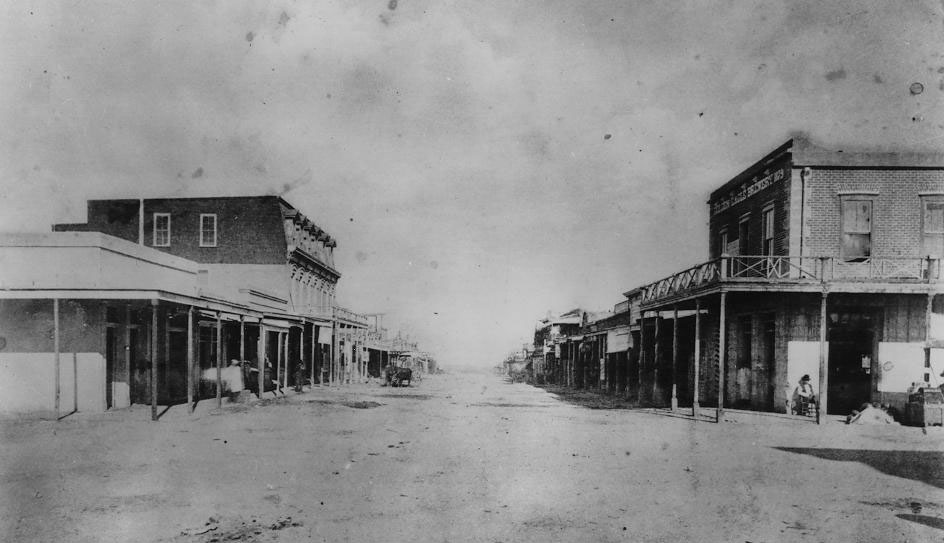
Can you imagine Democrat Bill Clinton dressed as a cowboy fighting a duel with
the aged Bob Dole, his adversary in the up-coming November Presidential election?
The scene is rather funny and reminds you of those comic strips that once in
a while appear in magazines that make fun of the President of the United States.
Satire aside, in America there really was a time when conflict of interest between
the Democrats and the Republicans was often settled with a pistol in hand. The
most famous example of this "political style" is the one that passed
into history as "Showdown at the O.K. Corral".
Hollywood has handed us down the heroic shoot-out in sixteen films, the first of which was "My Darling Clementine" by John Ford in 1946 starring the masterly Henry Fonda. In more recent times, the duel has been re-proposed in 1993 with "Tombstone" starring Kurt Russell and in 1994 with "Wyatt Earp" starring Kevin Costner. None of these films, however, have ever clearly explained to us that the famous showdown was due to the contrast between Democrats and Republicans for the control of the wealthy mining city of Tombstone.
The Earp Brothers were the champions of the Republicans who supported them with one of the two local newspapers, "The Tombstone Epitaph." The Democrats instead, supported above all by the many cowboys of the area, carried out their actions against the Earps through "The Daily Nugget."
But how did things really occur? Was it really a duel between "good and bad?" We get an answer from the judicial acts related to the investigation that were opened by Judge Spencer of the Court of Tombstone; acts that still today are kept in the archives of the Arizona Historical Society and the University of Arizona at Tucson. To shed light on that event, it is necessary to take a leap backwards of 115 years to a cold autumn afternoon on the plateau of Tombstone, in South East Arizona.
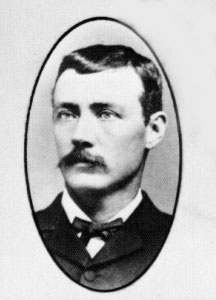 The air, in fact, was chilly that Wednesday, October 26,
1881 when, near 2:30 p.m., four armed men at once started walking with a decisive
footstep along Freemont Street, toward the rear entrance of O.K. Corral, where
the horses were kept. The three Earp Brothers and Doc Holliday were part of
the group. They stood between 5'8 and 5'9, slim, fair eyes, dark
blond hair and drooping moustaches; physically Virgil, Wyatt and Morgan Earp
looked a lot alike. They were also dressed the same way, with a three-quarter
black jacket, vest, white shirt with a black bow tie and hat, also black with
wide brims. Doc Holliday, who was as tall as the Earps, even if visibly thinner,
wore a derby hat that allowed a glimpse of his brown hair streaked with gray;
an aristocratic goatee accompanied his moustache and over his jacket he wore
a long gray overcoat that reached his knees. On the chest of Virgil Earp, 38
years old, shone the sheriff star of the city of Tombstone.
The air, in fact, was chilly that Wednesday, October 26,
1881 when, near 2:30 p.m., four armed men at once started walking with a decisive
footstep along Freemont Street, toward the rear entrance of O.K. Corral, where
the horses were kept. The three Earp Brothers and Doc Holliday were part of
the group. They stood between 5'8 and 5'9, slim, fair eyes, dark
blond hair and drooping moustaches; physically Virgil, Wyatt and Morgan Earp
looked a lot alike. They were also dressed the same way, with a three-quarter
black jacket, vest, white shirt with a black bow tie and hat, also black with
wide brims. Doc Holliday, who was as tall as the Earps, even if visibly thinner,
wore a derby hat that allowed a glimpse of his brown hair streaked with gray;
an aristocratic goatee accompanied his moustache and over his jacket he wore
a long gray overcoat that reached his knees. On the chest of Virgil Earp, 38
years old, shone the sheriff star of the city of Tombstone.
His brothers Wyatt Berry Stapp Earp, 33 years old, and Morgan S. Earp, 30 years old, had just been nominated his vice pro tempore together with John Henry "Doc" Holliday, 30 years old, to face the threat of five armed cowboys who ran about the city; the same ones who at that moment were in fact at the O.K. Corral.
The conflict went back to December 1879, when the Earps had moved to Tombstone with their wives and friends. There was a fourth brother, James, 40 years old, who was never involved with his brothers' business. Men of law and gamblers nearly by vocation, the Earps had a cloudy reputation. Only Virgil, a Civil War veteran and former federal marshal, had earned a good reputation in all the cities where he had worked. Wyatt, who in Tombstone owned the Oriental Saloon, aroused fear around him. As a former Dodge City marshal, he was famous for his speed with a gun, his unscrupulousness and his questionable friendships.
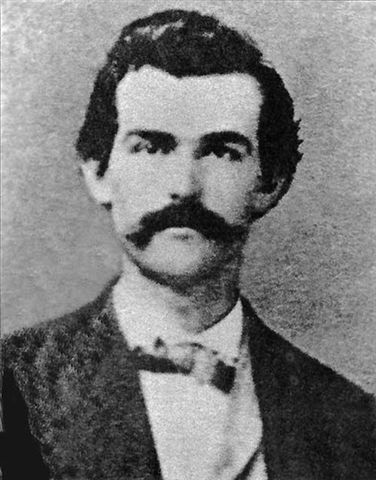 One very close friend of
his was Doc Holliday, who in Dodge City had saved his life by shooting down
three cowboys in a saloon. Holliday, in Tombstone lived with Hungarian Kate
"Big Nose" Elder, the madam of the brothel "The Golden Cage."
He came from a wealthy family in Valdosta, Georgia, and in 1872 he earned a
doctor degree as a dentist from the Pennsylvania College of Dental Surgery of
Philadelphia. Just a little later, he discovered he had tuberculosis, a deadly
disease in those years. Knowing he was doomed, he then decided to give up his
profession and good will to travel around the West spending all his time gambling
and consorting with hookers and swindlers of any kind. Bat Masterson, a gunman
who was his friend and ended his career in New York as a journalist, said Holliday's
hands were long and streamlined, nearly feminine. His hands were skilful enough
to handle both a pack of cards and a pistol, as Wyatt Earp admitted that his
friend Doc Holliday was faster than him. Both of them despised cowboys and what
they represented: a lack of rules, and the bullying attitude of those who resolve
all their problems by gunshots. In Tombstone, cowboys were the masters and they
scared people day and night with continuous shooting since the Earps came to
town. Cowboys, who were supporters of that frontier style which still now is
present in the mind of many Americans, were also the backbone of the Democratic
Party in Tombstone. To distinguish themselves, they used to carry a wrap of
red cloth knotted around their waist.
One very close friend of
his was Doc Holliday, who in Dodge City had saved his life by shooting down
three cowboys in a saloon. Holliday, in Tombstone lived with Hungarian Kate
"Big Nose" Elder, the madam of the brothel "The Golden Cage."
He came from a wealthy family in Valdosta, Georgia, and in 1872 he earned a
doctor degree as a dentist from the Pennsylvania College of Dental Surgery of
Philadelphia. Just a little later, he discovered he had tuberculosis, a deadly
disease in those years. Knowing he was doomed, he then decided to give up his
profession and good will to travel around the West spending all his time gambling
and consorting with hookers and swindlers of any kind. Bat Masterson, a gunman
who was his friend and ended his career in New York as a journalist, said Holliday's
hands were long and streamlined, nearly feminine. His hands were skilful enough
to handle both a pack of cards and a pistol, as Wyatt Earp admitted that his
friend Doc Holliday was faster than him. Both of them despised cowboys and what
they represented: a lack of rules, and the bullying attitude of those who resolve
all their problems by gunshots. In Tombstone, cowboys were the masters and they
scared people day and night with continuous shooting since the Earps came to
town. Cowboys, who were supporters of that frontier style which still now is
present in the mind of many Americans, were also the backbone of the Democratic
Party in Tombstone. To distinguish themselves, they used to carry a wrap of
red cloth knotted around their waist.
Many people didn't like this situation and at the end some of them called the Earps and fixed the star of marshal on Virgil's chest, begging him "to re-establish order again."
The first provision of the new marshal was the prohibition of using weapons inside the city borders. That decree provoked a lot of complaints, but it came anyway made to respect with the own Earps methods: the transgressor was arrested on the place, lead by the judge and fined. Weapons, of course, were seized.
But the Earps were not the only lawmen in town for long. In the next election, the cowboys' votes made Johnny Bean the new marshal of Cochise County. Bean hated the Earps for several reasons: he was a Democrat, and Wyatt Earp had stolen his woman. In fact, when he arrived in Tombstone, Wyatt was accompanied by Celia Ann "Mattie" Blaylock, whom he introduced as his second wife, even though they were not married. But destiny was in his way. One beautiful day, he met Josephine Sarah "Josie" Marcus, a beautiful dark-haired young woman, little more than 20 years old, from a wealthy Jewish family of San Francisco. Josie, came to Tombstone as a dancer in the theater company "Pinafore on Wheels," where until then she had been Bean's lover. It was the classic lightning blow: both of them abandoned their partners and lived together. Bean reacted to that betrayal by conspiring against the Earps. Mattie, instead, ended her days with her suicide in 1888 in a brothel in Pinal, Arizona.
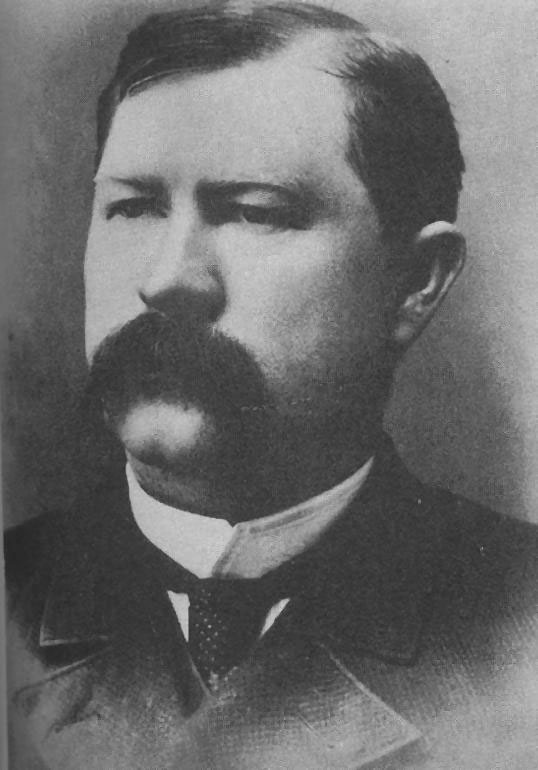 But let's go back to the O.K. Corral and see what really happened.
There were many eyewitnesses at the shooting. The Earps and Holliday were armed
with Colt "Peacemaker" 45 single action guns. Holliday's gun
was completely nickel-plated with an ivory grip. Suffering from a recent blood
crisis, the Georgian carried a nearby cane. Shortly before arriving at the O.K.
Corral, he passed the cane to Virgil who gave him a shotgun that he hid under
his overcoat. Virgil got the shotgun in the Wells Fargo office, the company
that managed stagecoach service.
But let's go back to the O.K. Corral and see what really happened.
There were many eyewitnesses at the shooting. The Earps and Holliday were armed
with Colt "Peacemaker" 45 single action guns. Holliday's gun
was completely nickel-plated with an ivory grip. Suffering from a recent blood
crisis, the Georgian carried a nearby cane. Shortly before arriving at the O.K.
Corral, he passed the cane to Virgil who gave him a shotgun that he hid under
his overcoat. Virgil got the shotgun in the Wells Fargo office, the company
that managed stagecoach service.
When they arrived at the crossing on Fourth Street, they finally saw them. William Harrison "Billy" Clanton, 19 years old, held his horse reins and spoke with Bean. Also in the group were William "Billy the Kid" Claibourne, 21 years old, the brothers Robert "Frank" and Thomas Clark "Tom" McLaury, respectively 33 and 28 years old, and Joseph Isaak "Ike" Clanton, 34 years old, the most dangerous of the four. During the past 24 hours, Ike spent most of his time drinking and publicly threatening the Earps and Holliday. Now, when they saw the group coming with guns-in-hand (only Virgil still had his Colt in his holster) they understood that things were bad. Bean took the initiative, walking towards the Earps trying to avoid the shooting.
"Gentlemen," he said, "I am the County marshal and I do not want trouble. Put back your guns and the others will do the same."
"The law is clear." Virgil answered. "I am the marshal of this city and I am going to disarm them." When he understood that there was nothing he could do, Bean left them and found shelter. The two groups were exactly eye-to-eye, so neighbors were able to touch each other, when Virgil spoke: "We came here in order to disarm and arrest you. Raise your hands, I want your weapons…"
"Don't talk nonsense, I do not want to fight," Tom McLaury answered, opening his jacket to show that he was disarmed.
"You sons of bitches wanted to defy us and now you can do it", Morgan shouted, cocking his gun.
"You great sons of bitches, now you can fight," Wyatt added, pressing his six-gun against Ike Clanton's stomach.
At that point, the situation exploded. It seems that Franck McLaury made an abrupt movement, like pulling out his Colt. Holliday, who was faster than a cat, fired suddenly. And the shooting began. A gun, that someone made disappear, appeared in Tom's hand.
"Just a moment, that's not what I want…" Virgil had
hardly the time to say. But he took the gun when his brother Morgan fell down,
hit in the right shoulder.
Two cowboys ran away. The first was Claibourne, who got his pants pierced by
a bullet. Clanton, instead, headed Wyatt's way and entered a photographic
studio while bullets whizzed past close to him. The "ka boom" of
Holliday's gunshot ended Tom McLaury's life in thirty seconds of
hellfire. Frank McLaury and Billy Clanton were on the ground, wet with their
own blood. The last one would die one hour later in the back of a shop. In the
throes of death, he kept repeating: "Give me more cartridges…"
Hollywood never told us, but all those stray bullets also killed two of the cowboys' horses. After Morgan, Virgil too was shot in the right leg. Also, a bullet grazed Holliday's belt, causing a two-centimeter scratch in his right side. Wyatt was safe and sound. He was on his feet, with the gun still smoking in his hand, when Josie, shaking, ran up to him and hugged him.
 Meanwhile, red with rage,
Sheriff Bean showed up. "You are all under arrest," he shouted.
"Not even if you were God Almighty could you arrest me today, "
Wyatt Earp answered icily looking at him in the eyes. And he left him there,
still and impotent, while he took his brothers home with some friends'
help and under guard.
Meanwhile, red with rage,
Sheriff Bean showed up. "You are all under arrest," he shouted.
"Not even if you were God Almighty could you arrest me today, "
Wyatt Earp answered icily looking at him in the eyes. And he left him there,
still and impotent, while he took his brothers home with some friends'
help and under guard.
The Earp brothers understood that the air was too heavy for them when they saw the crowd that took part at the funeral of the three dead men at the O.K. Corral. Hundreds of people (local news said at least four hundred) walked with the coffins, band ahead, to the Boot Hill cemetery. And on the graves, Sheriff Bean put a wood tombstone where he wrote that the three men "were killed on the streets of Tombstone."
Judge Wells Spicer opened an inquiry into the shooting at the O.K. Corral and he heard all the eyewitnesses, included the Earp brothers and Holliday. Clanton and Claibourne testified against the Earp, but their own destiny was already signed.
On November 14, 1892 Billy Claibourne got the unhappy idea to provoke barman "Buckskin" Frank Leslie and he got a bullet in the forehead.
Ike Clanton keep on rustling cattle, and on June 1, 1897 detective J.V. Brighton, who was looking for him with Sheriff Miller, killed him.
Returning to the inquiry, Wyatt and Doc were both arrested. Then on December 1, 1891, the acquittal and the release: the shooting at the O.K. Corral, we can read in the grounds of judgment, was a lawful police action.
But the story didn't end in that way. On the evening of December 28, 1891, while he was crossing Fifth Street, where no more than five or six meters separated the Oriental Saloon from the Crystal Palace Saloon, Virgil was the target of an attack that left him an invalid for life. In the dusk, somebody fired twice with a shotgun against him and the bullets ravaged his left arm and wounded his back. For the rest of his existence Virgil would not be able to use that arm.
Exactly three months later, on the evening of Saturday, March 18, 1892, Morgan Earp was killed by a gunshot that broke his vertebral column while he was playing billiards in the Bob Hatch's Saloon and Billiard Parlor. Even that time, the killer acted in the shadows and nobody saw who he was. A few days later, the Earp brothers left Tombstone, but not together. Wyatt Earp, who meantime earned the star of federal marshal, put his relatives on the train to California at the Tucson rail station and together with Doc Holliday and three other friends started his own personal revenge. And it was a massacre: Frank Stilwell, whom Wyatt considered Morgan's killer, was shot down in Tucson; Johnny Ringo, the most skilful gunman who earned a college degree in English, champion of the cowboys, was found dead seated half-naked on a cliff with half of his skull removed by a gunshot. And many other cowboys who belonged to the Democratic Party died in the same way, but without any witnesses. Then Bean organized a posse that went up and down through Southern Arizona in a vain search for Earp and Holliday. But on their way they found only dead men. And all of them wore a red wrap around their belts.
When their work was completely done, Wyatt and Doc moved to Colorado, let the situation calm down and then each of them took his own way. The two great friends would never meet again. Doctor John Henry Holliday, on November 8, 1887, died on a bed in a squalid hotel in Glenwood Spring, Colorado, a city where you can still find his grave. Near his deathbed there was only a boy who, for few dollars every day, shopped for food for him since he was too sick to go out. It seems that the last words of Holliday were: "It's funny, to die without my boots on my feet…" He was 36 years old.
Wyatt Earp, instead, returned to Josie and together they lived almost a half-century of adventures. They also took part at the race for gold in Alaska. Virgil, as partial reward for his arm crippled in Tombstone, got a twelve dollars monthly pension and died of pneumonia in Goldfield, Nevada, on November 20, 1905 while he was serving as sheriff of Esmeralda County. He was 62 years old. His wife Allie, who wrote in a book of her contempt toward her brother-in-law Wyatt, buried her husband in Portland, Oregon.
Only Wyatt lived the longest. The "Lion of Tombstone," as the press of that age called him, had settled down in Los Angeles where he had become part of the community as businessman in the real estate industry. He also became an esteemed exponent of the local Masonry. In his spare time, he carried out the role of adviser for the newborn cinematographic industry of Hollywood. And he died in Los Angeles on the morning of January 13 1929, three months before his 81st birthday, from cystitis.
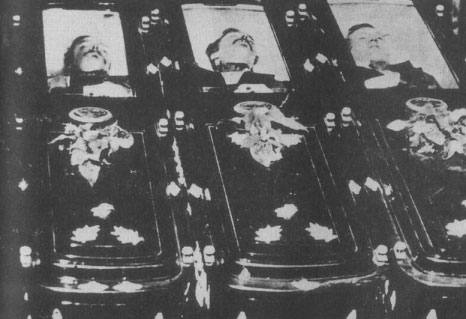 Thousands of people took part
at his funeral, many of whom were his last friends of his golden years. There
was also Tom Mix, the first western hero of the silent cinema, who didn't
hide his tears. "The Los Angeles Evening Herald" that day came up
with a large headline: "The West's old men pay a last tribute to
Wyatt Earp." The body of the "frontier marshal" was buried
in the Colma cemetery, a one-hour drive from San Francisco, near an empty grave.
And it was there that in 1944 Josie would join him. That small cemetery, nearly
to remember a man and an era committed to history, is called "The Hill
of Eternity."
Thousands of people took part
at his funeral, many of whom were his last friends of his golden years. There
was also Tom Mix, the first western hero of the silent cinema, who didn't
hide his tears. "The Los Angeles Evening Herald" that day came up
with a large headline: "The West's old men pay a last tribute to
Wyatt Earp." The body of the "frontier marshal" was buried
in the Colma cemetery, a one-hour drive from San Francisco, near an empty grave.
And it was there that in 1944 Josie would join him. That small cemetery, nearly
to remember a man and an era committed to history, is called "The Hill
of Eternity."
But what about Tombstone? The city was abandoned in the first years of the twentieth century because of an underground river that flooded the silver mines. In recent years, Tombstone has been reconstructed, to the joy of tourists who come from all over the world to admire the historical places of this piece of desert. In fact, every Sunday, about 2:30 p.m., the local tourist agency recalls the mythical duel with actors. Like then, even now Democratic and Republican people speak about politics at the Crystal Palace Saloon, but without hostility and in the shadow of one blow-up of John Wayne. What's important is showing off for all the Japanese who, drinking Coca Cola, take pictures of everything. Besides, all Tombstone is made for tourists, even the old Boot Hill cemetery. In order to visit that barren hearth handkerchief covered by old tombstones, you need to pass through a souvenir store And for two dollars and 89 cents, you can take home a black and white brochure with the pictures of the three men died at the O.K. Corral lying in their coffins.
© ALL REPRODUCTION RIGHTS RESERVED – Websites, blogs, social media, newspapers, magazines, tv or radio broadcasts, wishing to use the contents of this article for public distribution, MUST MENTION THE RINODISTEFANO.COM WEBSITE AS SOURCE.
(Most of the information about the O.K. Corral Gunfight is based on the book And Die in the West: The Story of the O.K. Corral Gunfight by author Paula Mitchell Marks, ISBN 9780806128887. The local research was made by myself at Tombstone. Some pictures were kindly provided by the Arizona Historical Society.)
My Books | My Articles | Events & News | Multimedia
Facebook | Twitter | YouTube | Instagram | Contact
© 2001-2024 Rino Di Stefano – Partial or total reproduction prohibited without permission
Copyright Statement – Privacy Policy
